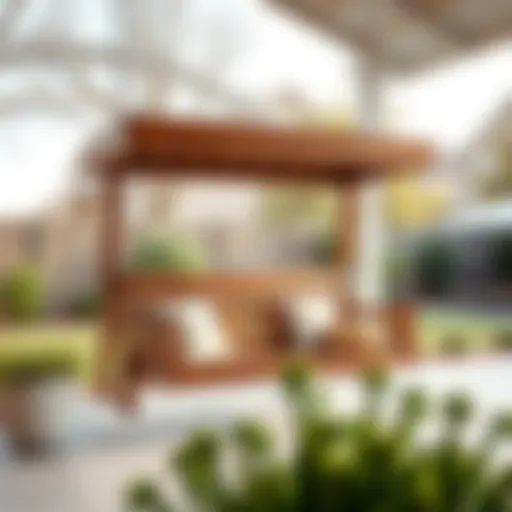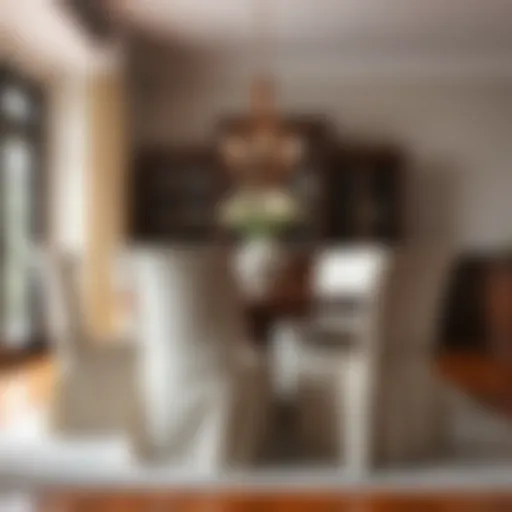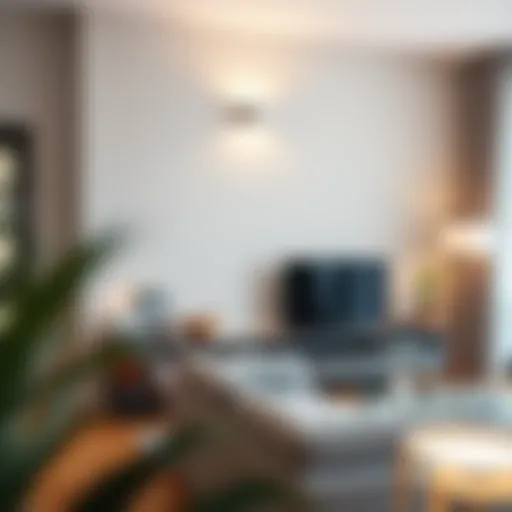The Beauty and Functionality of Wicker Shade Lamps


Intro
Lamps with wicker shades are not just practical sources of light; they are compelling design elements that can create a cozy ambiance in any room. Their intricate weaves tell a story, one that resonates with the tradition of craftsmanship and the charm of natural materials. As we explore the world of wicker-shaded lamps, we find that they perfectly blend aesthetics with functionality.
The allure of these lamps lies in their versatility. They can seamlessly enhance various interior styles, from bohemian to rustic to modern chic. For homeowners, renters, and designers alike, understanding the nuances of wicker-shaded lamps becomes vital in making informed décor choices. Moreover, the growing fascination with sustainable living and eco-friendly materials amplifies the appeal of these lights, offering not just beauty but also mindful consumption.
In this article, we'll dive into the latest furniture trends surrounding wicker lamps, explore DIY projects to personalize your space, and offer tips for maintenance. Additionally, we'll provide historical context, showcasing how wickerwork has evolved in lighting design. This exploration aims to serve as a comprehensive guide for enthusiasts and novices alike, illuminating the path to stylish living.
Understanding Wicker Craftsmanship
Wicker craftsmanship brings a unique blend of artistry and functionality, highlighting a rich tapestry of history, materials, and techniques. As the use of lamps with wicker shades gains popularity, understanding the craftsmanship involved is essential for those looking to add character to their homes. While many appreciate the aesthetic allure of wicker lamps, grasping the intricate methods that go into creating these pieces can elevate the overall appreciation and selection process of such items.
Wickerwork is not merely a craft; it’s a narrative woven through generations. The skills required are often handed down from master artisans to eager apprentices, creating a deep cultural significance. In this segment, we will break down the crucial aspects of wicker craftsmanship, delving into its history, the materials that define it, and the weaving techniques that shape the noticeable differences in the lamps we see today.
History of Wickerwork in Lighting
The origins of wickerwork can be traced back to ancient civilizations, where natural materials were utilized for various purposes, including lighting. As societies evolved, so did the methods and styles. Wicker lamps began to appear in domestic settings in the 19th century, coinciding with the rise in popularity of decorative arts. This period saw a surge in interest for handmade items, spurred on by the Arts and Crafts movement, which sought to bring back quality, craftsmanship, and authenticity to design. Understanding this history is vital, as it frames the evolution and importance of wicker lamps in contemporary settings.
Materials Used in Wicker Lampshades
Natural Fibers
Natural fibers, such as rattan and willow, stand out due to their sustainability and tactile qualities. They contribute significantly to the overall aesthetic and texture of wicker lampshades. The key characteristic here is their ability to be shaped into intricate patterns while maintaining durability. This makes them a popular choice among consumers looking for both beauty and strength. The unique feature of natural fibers lies in their organic appearance, which can soften the starkness of modern decor. Nevertheless, they can be prone to fraying or fading over time, so selecting high-quality materials is imperative for longevity.
Synthetic Materials
On the other hand, synthetic materials have emerged as an alternative worth considering. They offer versatility in design and robustness that natural fibers might lack. The major advantage of synthetics is their weather resistance and lesser maintenance compared to natural alternatives. They can be crafted into various shapes and colors, opening doors for innovative designs. However, one must consider the environmental impact of these materials, as they are not biodegradable. It's a balancing act between aesthetics and sustainability.
Environmental Considerations
In today’s ecological climate, environmental considerations hold weight when selecting materials for wicker lamps. The emphasis on sustainability fosters a growing marketplace for eco-friendly options, such as bamboo or recycled plastics, lending credence to the importance of this aspect. Bamboo grows rapidly, making it a sustainable choice. Moreover, using recycled plastics not only conserves natural resources but also reduces landfill waste. Consumers increasingly prefer products that tell an environmental story, enhancing the appeal of wicker lamps as tools for sustainable living.
Techniques of Wicker Weaving
Traditional Weaving Methods
Traditionally, the art of wicker weaving involves intricate hand methods passed down through generations. The key characteristic of these techniques lies in their reliance on the artisan’s skill, producing unique and high-quality pieces. Each lamp created showcases individuality, telling its own story through weave patterns. While traditional methods may require more time, the craftsmanship yields stunning results that mass production cannot replicate. The downside, however, is the cost; these lamps can be more expensive but often justify their price through quality and artistry.
Modern Innovations
As times change, so does craftsmanship. Modern innovations in wicker work have introduced new materials and techniques that allow for seamless blending of traditional styles with contemporary aesthetics. One remarkable feature of modern innovations is the incorporation of technology, such as computer-aided design, enabling precise production that was previously unimaginable. However, the con of innovation is sometimes a perceived loss of character and the handcrafted charm that defines traditional wicker making.
Regional Variations in Craftsmanship
Regional variations in craftsmanship provide insight into cultural influences that shape how wicker lamps are designed and produced. Each area may utilize local materials or specific techniques unique to its tradition. For instance, Indonesian artisans may favor rattan due to its abundance, while craftsmen in Europe often prefer willow for its pliability. This diversity not only enriches the global landscape of wicker design but also allows consumers to choose lamps that resonate with their personal taste and values. However, it is vital to understand the source and sustainability of materials used in regional styles to ensure that such choices do not compromise ethical considerations.
Aesthetic Appeal of Wicker-Shaded Lamps
The allure of wicker-shaded lamps rests not just in their functionality but in their ability to transform a space. Wicker brings an organic touch to interiors, and the interplay of light through woven fibers adds a unique ambiance. These lamps evoke a sense of warmth and relaxation, drawing attention without overwhelming a room. It’s this balance of beauty and practicality that makes them so appealing.
When one considers the aesthetic appeal of these lamps, it’s essential to understand the myriad design styles they complement. They can seamlessly integrate into various environments, turning a simple room into a cozy retreat. This section explores how wicker shades enhance design themes, color palettes, and textures, contributing to the overall atmosphere of any space.
Design Styles Complemented by Wicker
Modern Minimalism
Modern minimalism embraces simplicity and functionality, focusing on clean lines and uncluttered spaces. Wicker shades fit snugly within this aesthetic, providing texture against a backdrop of muted colors and streamlined furniture. Their handcrafted nature contrasts beautifully with the starkness of minimalism, adding a layer of warmth that softens the overall look. This unique feature is vital, as it introduces an element of nature into the space, thereby making it feel more inviting.
This style stands out for its beneficial quality of promoting serenity; a modern minimalist room adorned with a wicker lamp often becomes a soothing place. The simplicity of the design allows for focus on light quality, enhancing the ambiance without distracting from other design elements.
Bohemian Flair


Bohemian flair is all about personal expression and eclecticism, merging patterns, colors, and textures into a harmonious yet vibrant aesthetic. Wicker lamps, with their artisanal roots, embody this free-spirited ethos perfectly. These lamps celebrate handcrafted elements, making them a wonderful addition to a boho space. The organic shapes and varying hues of wicker can complement colorful textiles and layered decor elements.
As a popular choice in today’s design landscape, a wicker lamp in a bohemian setting often acts as a statement piece. However, one must be careful, as too much eclecticism can lean into chaos. Balancing the randomness with intentional placement of wicker lamps can ensure a space remains harmonious.
Coastal Decor
Coastal decor exudes a breezy, relaxed vibe, often featuring light colors and natural materials reminiscent of seaside living. Wicker-shaded lamps harmonize beautifully in such environments, enhancing the airy feel desirable in coastal design. They can mimic the fluid shapes of natural elements found in coastal areas, such as waves or driftwood.
The key characteristic of coastal decor is its commitment to serenity and tranquility, making wicker lampls an ideal match. Moreover, these lamps bring a tactile element to decor that mirrors sand and beach grass, grounding the airy concepts of coastal styling. However, one must ensure that wicker doesn’t dominate; keeping a balance with other elements is fundamental to achieving that breezy ambiance.
Color Palettes and Textures
Neutral Tones
Neutral tones serve as a versatile foundation for interior design. They create a calming backdrop that allows other design elements, including wicker lamps, to shine. Utilizing neutral colors with wicker allows for easy integration into any space. A wicker lamp in a neutral palette can draw attention to its texture without overwhelming the overall scheme.
This approach is beneficial in its flexibility. Neutral tones pair well with virtually any accent color or material, allowing homeowners to tweak elements of design without starting from scratch.
Bold Accents
Bold accents can invigorate a space, creating focal points that command attention. Whether in the form of vibrant colors or striking patterns, these accents are essential in waking up a room. Wicker lamps outfitted with bold hues or intricate designs can serve as pivotal pieces that anchor the surrounding decor organically.
As a unique feature, the combination of bold accents with the natural look of wicker can balance playfulness with restraint, achieving an aesthetically pleasing outfit for any room. Care should be taken, however; too many bold elements with a wicker shade can lead to visual chaos.
Contrasting Textures
Contrasting textures is a dynamic way to add interest to a room. Pairing wicker with sleek metals or smooth fabrics introduces depth and richness to a space. This thoughtful layering can elevate the visual experience, inviting guests to explore and touch different materials.
The significance of contrasting textures is quite pronounced in wicker lamps; these pieces can bridge the gap between rough and polished surfaces, enhancing the tactile experience in any room without compromising the design integrity. This can sometimes be a hit or miss—finding the right juxtaposition is key.
Functional Benefits of Wicker Lamps
Lamps with wicker shades bring a variety of practical advantages to indoor spaces. While many people appreciate their aesthetic appeal, the functional elements shouldn’t be overlooked. These lamps are not only useful for illuminating spaces but they also enhance the ambiances and experiences within rooms. Understanding these benefits can help homeowners, renters, and designers alike in selecting the perfect wicker lamp for any situation.
Lighting Quality and Diffusion
Soft Ambient Lighting
Soft ambient lighting is a hallmark of wicker lamps. The woven nature of wicker allows light to gently filter through, creating a cozy and inviting atmosphere. This type of lighting is particularly valued in spaces where relaxation is key, such as living rooms and bedrooms. One major advantage of soft lighting is its ability to reduce eye strain, making it a perfect option for evening gatherings or winding down after a long day. However, the subtlety of this lighting might not suit all needs, particularly in areas requiring focused task lighting, like home offices or kitchens.
Highlighting Decor
When placed strategically, wicker lamps can also enhance the beauty of decor items. Their unique textures and earthy tones help to create focal points within a room. They can frame artwork, accentuate floral arrangements, or even make a statement with simple yet impactful design. The ability of wicker lamps to highlight decor is significant; they do so without overwhelming other elements in the room. However, care must be taken to ensure the lamp’s light does not clash with other light sources, which could lead to an unbalanced feel in the space.
Reducing Glare
Wicker lamps also excel at reducing glare, a common issue with traditional lamps that often use hard glass shades. The woven fibers effectively diffuse light, allowing it to spread evenly without harsh reflections or blinding spots. This feature is particularly useful in settings where people tend to spend extended periods, such as reading corners or media rooms. However, while this characteristic is a boon for comfort, it may limit the effectiveness in situations where brighter, more direct lighting is sought.
Versatility in Placement
Table Lamps
Wicker table lamps shine in their adaptability, fitting seamlessly into a variety of spaces—from bedside tables to office desks. Their sizes can range, making them suitable for both small and large surfaces, and they add a pleasing touch of nature to interiors. A key reason for their popularity lies in their ability to be easily moved from one location to another, allowing homeowners to adjust their decor with ease. However, ensure they are proportional to the surrounding furniture to avoid fighting for attention.
Floor Lamps
Wicker floor lamps present an opportunity to add height and dimension to a room. Standing tall, they illuminate areas that might otherwise be overshadowed by lower furnishings. They can serve as statement pieces or complement existing decor effortlessly. The downside could be their size, as larger models may crowd smaller spaces. However, in spacious areas, they can make a magnificent impression, drawing the eye upward and creating a sense of openness.
Wall Sconces
Wall sconces featuring wicker shades are superb for adding character without occupying valuable floor or table space. These fixtures can illuminate hallways or flanking mirrors, establishing a charming atmosphere in both modern and traditional homes. One advantage of wall sconces is their ability to highlight vertical surfaces, drawing attention to architectural features in a room. A potential downside is their less flexible installation; once mounted, changing their position can be complex.
Incorporating Wicker Lamps in Interior Design


Incorporating wicker lamps into interior design is more than just a passing trend; it speaks volumes about one’s style and the effective use of natural materials to enhance living spaces. Wicker lamps have a unique charm that allows them to fit seamlessly into various decor styles. Their versatility offers something for everyone, making them a topic worth exploring in depth.
Room-Specific Applications
Living Rooms
When it comes to living rooms, wicker lamps add a layer of texture and warmth that can create a welcoming atmosphere. They serve not just as lighting fixtures but as statement pieces that anchor the overall design. One key characteristic of living rooms is their role as social hubs. The soft glow from wicker shades helps set a relaxed mood, making it a popular installation choice in homes. Moreover, these lamps come in various shapes and sizes, fitting well on side tables or as tall floor lamps. However, one must be cautious about their placement; too much natural light filtering through wicker can lead to a glare that distracts from evening activities.
Bedrooms
In bedrooms, wicker lamps contribute to a serene environment. The gentle diffusion of light helps create a cozy sanctuary for rest and relaxation. A significant aspect of bedrooms is personal comfort, and wicker shades offer some physical warmth, making them a beneficial choice for nocturnal spaces. Their unique feature lies in how they soften bright light, promoting better sleep hygiene. On the flip side, if one prefers brighter lighting for tasks like reading, wicker might not always provide sufficient illumination without supplementing other lighting sources.
Outdoor Spaces
Wicker lamps also shine in outdoor spaces. In patios or gardens, these lamps can set a tranquil ambiance for evening gatherings. The key characteristic of outdoor wicker lamps is their durability; many are treated to withstand the elements, making them a viable option for alfresco settings. This quality allows homeowners to extend their living space outdoors, creating an inviting atmosphere. However, ensure the wicker used is weather-resistant, as moisture can lead to deterioration over time.
Combining with Other Furnishings
Pairing with Wooden Furniture
Pairing wicker lamps with wooden furniture is a classic move that can elevate any room's aesthetic. The natural fibers of wicker complement the organic textures of wood, creating harmony within the space. This mix often brings warmth and a touch of rustic charm, making it a favorable choice for country or farmhouse styles. However, overdoing natural elements can sometimes clutter the visual palette, so balance is key.
Contrasting with Metal Accents
Contrasting wicker lamps with metal accents can create a striking statement. Metals such as brass or polished nickel can bring a modern edge to the warm and earthy appeal of wicker. This juxtaposition highlights the unique qualities of each material, resulting in a visually dynamic effect. While some may worry about compatibility between these contrasting materials, when executed properly, this combination can be visually stunning and sophisticated. Just pay attention to the color palettes to maintain coherence throughout the space.
Complementing Fabrics and Textures
Complementing fabrics and textures with wicker lamps can enhance the overall styling of a room. Soft textiles in cushions and drapes can contrast beautifully with the rigid structure of a wicker lamp. The aim here is to create a layered look that invites touch and visual curiosity. Homeowners should consider mixing patterns, weaving in floral fabrics with solid wicker to enliven the space without overwhelming it. However, attention to detail is crucial; too many competing textures can create chaos rather than cohesion.
In summary, incorporating wicker lamps into your interior design repertoire offers numerous benefits, from enhancing atmosphere to adapting to various styles. Consider each room's unique characteristics and furnishings to ensure that your lighting choices enhance, rather than detract, from your overall design vision.
Sustainability and Ethical Sourcing
Sustainability and ethical sourcing are no longer just buzzwords; they are pivotal components in how we make choices about everyday objects, including wicker-shaded lamps. As awareness grows about environmental issues and social responsibility, discerning consumers are looking for products that not only light up their homes but also support sustainable practices and contribute positively to society. In this section, we'll examine various elements of sustainability in wicker lamp production, such as the choice of materials and the impact on local communities.
The use of eco-friendly materials ensures that the production of wicker lamps has a lower environmental footprint. This is just as crucial in terms of conserving natural resources as it is in reducing waste. Furthermore, ethical sourcing means that the artisans behind these beautiful pieces are compensated fairly, leading to the promotion of local economies and craftsmanship. So, not only do these lamps serve a functional purpose, but they also weave a story of care and responsibility into the very fabric of their design.
Eco-Friendly Materials in Wicker Lamps
Bamboo
Bamboo is often touted as a prime candidate for sustainable furnishings, and it’s easy to see why. This fast-growing grass can reach maturity in just three to five years, making it a highly renewable resource in contrast to traditional wood, which can take decades to grow. Its ability to absorb carbon dioxide and produce oxygen at a higher rate than most trees adds to its appeal.
Using bamboo in wicker lamps not only allows for diverse designs but also contributes to a reduction of deforestation. Additionally, bamboo’s natural resilience and strength make it a durable choice. However, it is vital that the bamboo is sourced responsibly, as overharvesting can still pose environmental challenges.
Recycled Plastics
In a world laden with plastic waste, incorporating recycled plastics into wicker lamps serves as a brilliant solution. By using recycled materials, manufacturers are not only decreasing the demand for new resources but also helping to minimize the plastic waste that clogs up landfills and oceans.
The unique feature of recycled plastics is their versatility; they can be processed into various forms to mimic traditional wicker designs, offering a renewed aesthetic while being eco-friendly. Still, some people might question the durability and aesthetic appeal compared to natural fibers. It’s essential to consider how these lamps fit into a sustainable lifestyle while being mindful of their longevity and visual impact.
Locally Sourced Rattan
When it comes to natural wicker materials, locally sourced rattan stands out. This vine is abundant in tropical regions, making it easier to harvest without depleting resources. By opting for rattan that’s harvested nearby, it cuts down on transportation emissions, further promoting a sustainable approach.
Rattan adds a unique texture and warmth to lamps, making them suitable for various design styles. As a fast-growing plant, it allows for the regeneration of the ecosystem, meaning rattan can be replenished easily. Nevertheless, it’s crucial to purchase rattan that comes from well-managed forests to ensure that this practice remains sustainable.
Supporting Artisan Communities
Fair Trade Practices
Fair trade practices go a long way in ensuring that artisans who create wicker lamps receive just compensation for their labor. This encourages quality craftsmanship and ethical labor standards, providing artisans a decent livelihood. Fair trade doesn’t just help with income; it also fosters a sense of community and pride in their work, often leading to better craftsmanship.


Choosing lamps that use fair trade materials means supporting a system that values people over profit. This approach may reflect higher costs, but it’s a worthy investment that encourages sustainable practices and ethical treatment of artists. Ultimately, fair trade practices lay down a foundation for social responsibility in the marketplace.
Promoting Craftsmanship
Promoting craftsmanship involves more than just appreciation; it elevates the worth of handmade items. By opting for beautifully crafted wicker lamps, there’s a recognition of the skills and traditions that have been passed down through generations. Each lamp becomes not just a product, but a piece of art, embodying the culture and heritage of its maker.
When consumers choose quality craftsmanship, they advocate for small businesses and the preservation of traditional techniques. This can even lead to the revitalization of communities where artisans are struggling. The downside? Handmade items may take longer to produce and often come at a premium, but the uniqueness and character they bring to a space are undeniably worth it.
Impact on Local Economies
Supporting local economies through the purchase of wicker lamps can have a remarkably positive impact. When consumers choose locally made products, they are investing in their community and helping small businesses thrive. This chain effect can stimulate job growth and encourage more artisans to pursue their craft.
Additionally, as local economies are bolstered, they can foster conditions conducive to sustainable practices. Local artisans are often more in tune with their environment, leading to innovations that integrate sustainability more seamlessly than mass production methods. However, it's essential to remain conscious that not all labeled "local" sources are sustainable, so doing research into specific suppliers is vital.
Maintenance and Care for Wicker Lamps
Maintaining wicker lamps is essential for preserving their beauty and functionality over time. These unique pieces, often handcrafted, require attentiveness and care to ensure they stand the test of time in both design and durability. Proper maintenance not only enhances their visual appeal but also extends their lifespan, making it a worthy investment for homeowners and decorators alike.
Cleaning Techniques
Regular Dusting
Regular dusting plays a significant role in the upkeep of wicker lamps. The key characteristic of this method is its simplicity, requiring just a soft cloth or a duster to lift away dust that can accumulate in the woven structure. It’s a popular choice for maintaining wicker because it prevents dirt from deep-seating into the fibers, which can only cause more extensive cleaning later. One unique feature of regular dusting is that it ensures that the lamp retains its original charm without any harsh cleaning agents that might cause damage. The advantage here is clear: it forms a protective habit that can easily be integrated into your home routine.
Deep Cleaning Methods
Deep cleaning methods are vital when wicker lamps are subjected to heavier dirt or stains. This approach often involves using mild soap and water, carefully applying it to a cloth to avoid soaking the wicker. The key characteristic of this technique is its thoroughness; it dives deeper than regular dusting to preserve the integrity of the lamp. A unique feature is the potential use of a toothbrush for reaching those tight areas that dust may settle in. However, be cautious—while deep cleaning rejuvenates its appearance, excessive moisture can weaken the fibers, so it should be approached with care.
Preventing Damage
Implementing strategies for preventing damage is crucial for maintaining wicker lamps. One effective measure involves placing lamps in areas where harsh sunlight or moisture isn’t a factor, as these elements can lead to fading and degradation. The key characteristic of this approach is its proactive nature; it addresses potential issues before they arise. This focus on prevention offers a long-term advantage, allowing owners to enjoy their lamps without frequent repairs or restorations.
Longevity Tips
Avoiding Moisture
Avoiding moisture is paramount, especially for wicker lamps. Water can soften the woven materials, leading to warping or even mold development. The key characteristic of this principle is the emphasis on environment—wicker should be in spaces with low humidity levels. This is a beneficial choice as it guards against deterioration and keeps the lamp looking fresh. A unique consideration is to offer additional ventilation in areas where moisture is inevitable; this helps create a balanced atmosphere for your lamps.
Storage Recommendations
When it comes to storage recommendations, properly storing wicker lamps when not in use is essential. The key characteristic of this practice is finding a dry and cool space, away from direct contact with other heavy objects which could harm the shape of the lamp. Storing these pieces as per recommended guidelines can prevent unintentional damage. Notably, disassembling components such as lampshades makes it an easy option, but it requires proper labels for a hassle-free reassembly later on.
Repair Techniques
Repair techniques come into play when a wicker lamp shows signs of wear. The key characteristic of this aspect is the ability to fix minor issues before they escalate into larger problems. Learning simple techniques like reweaving is particularly beneficial as it empowers the owner to revitalize the lamp personally. However, seeking professional help for significant repairs is often advised—while DIY repairs can save money, improper techniques can lead to further issues.
Maintaining and caring for wicker lamps isn't just about cleaning; it’s about making the environment right and nurturing these pieces so they can continue to brighten our spaces for years to come. Whether you’re a homeowner or a designer, understanding these essentials ensures that your wicker lamps remain stunning focal points in your rooms.
End: The Enduring Allure of Wicker-Shaded Lamps
In wrapping up our exploration of lamps adorned with wicker shades, it's crucial to reflect on the significance that these pieces hold in the world of interior design and functional lighting. Wicker-shaded lamps are not merely lighting fixtures; they embody a fusion of craftsmanship, environmental consciousness, and aesthetic versatility that enhances any living space.
Timeless Craftsmanship
The allure of wicker lamps transcends surface appeal. Each piece tells a story of artisanal skill and tradition, showcasing techniques passed down through generations. When you light your room with one of these lamps, you’re not just using a source of illumination; you’re participating in a long-standing tradition of craftsmanship that respects both the art of design and the artisans behind it.
Environmental Benefits
Moreover, as homeowners and consumers grow increasingly conscious of sustainability, wicker lamps, typically made from natural fibers like rattan or bamboo, present an eco-friendly option. By choosing these pieces, individuals support sustainable practices and contribute to a greener planet. It’s a twofold benefit: beautifying your space while adhering to an ethical framework.
Versatile Style
Wicker shades can blend seamlessly into various home styles, from coastal chic to rustic elegance. This adaptability enables homeowners to incorporate these lamps effortlessly into their designs. Aesthetically pleasing and functional, wicker lamps offer soft and ambient lighting that creates warmth in a room. They serve as focal points or subtle additions, depending on how they are used within a space.
Wicker lamps are more than just functional objects; they mirror a lifestyle choice towards sustainable living and timeless design.
Final Considerations
However, potential buyers should also consider both the maintenance and placement of these units to maximize their longevity and visual impact. Understanding proper care techniques can enhance their durability, ensuring these beautiful pieces can be enjoyed for years to come.















